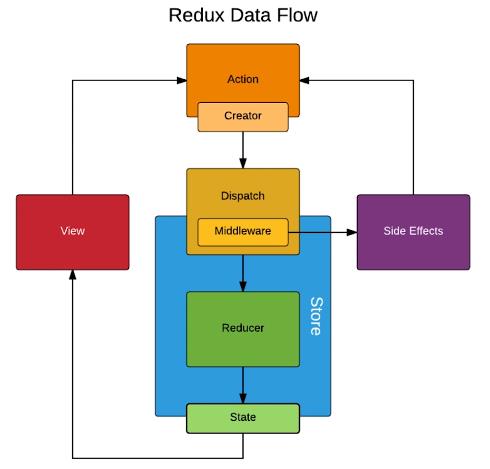
杨会清的个人网站
爱生活,爱编程,学习使我快乐

爱生活,爱编程,学习使我快乐
当一个组件内容比较多,同时有逻辑处理和UI数据渲染时,维护起来比较困难。这个时候可以拆分成“UI组件”和”容器组件”。
拆分的时候,容器组件把数据和方法传值给子组件,子组件用props接收。
需要注意的是:
子组件调用父组件方法函数时,并传递参数时,可以把方法放在箭头函数中(直接在函数体使用该参数,不需要传入箭头函数)。
拆分实例
未拆分前原组件
import React, {Component} from 'react';
import 'antd/dist/antd.css'; // or 'antd/dist/antd.less'
import { Input, Button, List } from 'antd';
// 引用store
import store from './store';
import { inputChangeAction, addItemAction, deleteItemAction } from './store/actionCreators';
class TodoList extends Component {
constructor(props) {
super(props);
// 获取store,并赋值给state
this.state = store.getState();
// 统一在constructor中绑定this,提交性能
this.handleInputChange = this.handleInputChange.bind(this);
this.handleStoreChange = this.handleStoreChange.bind(this);
this.handleClick = this.handleClick.bind(this);
// 在组件中订阅store,只要store改变就触发这个函数
this.unsubscribe = store.subscribe(this.handleStoreChange);
}
// 当store状态改变时,更新state
handleStoreChange() {
// 用从store中获取的state,来设置state
this.setState(store.getState());
}
render() {
return (
<div style={{margin: '10px'}}>
<div className="input">
<Input
style={{width: '300px', marginRight: '10px'}}
value={this.state.inputValue}
onChange={this.handleInputChange}
/>
<Button type="primary" onClick={this.handleClick}>提交</Button>
</div>
<List
style={{marginTop: '10px', width: '300px'}}
bordered
dataSource={this.state.list}
renderItem={(item, index) => (<List.Item onClick={this.handleDelete.bind(this, index)}>{item}</List.Item>)}
/>
</div>
)
}
// 组件注销前把store的订阅取消
componentWillUnmount() {
this.unsubscribe();
}
// 输入内容时(input框内容改变时)
handleInputChange(e) {
const action = inputChangeAction(e.target.value);
store.dispatch(action);
}
// 添加一项
handleClick () {
const action = addItemAction();
store.dispatch(action);
}
// 点击删除当前项
handleDelete (index) {
const action = deleteItemAction(index);
store.dispatch(action);
}
}
export default TodoList;
拆分后-容器组件
import React, {Component} from 'react';
// 引用store
import store from './store';
import { inputChangeAction, addItemAction, deleteItemAction } from './store/actionCreators';
import TodoListUI from './TodoListUI';
class TodoList extends Component {
constructor(props) {
super(props);
// 获取store,并赋值给state
this.state = store.getState();
// 统一在constructor中绑定this,提交性能
this.handleInputChange = this.handleInputChange.bind(this);
this.handleStoreChange = this.handleStoreChange.bind(this);
this.handleClick = this.handleClick.bind(this);
// 在组件中订阅store,只要store改变就触发这个函数
this.unsubscribe = store.subscribe(this.handleStoreChange);
}
// 当store状态改变时,更新state
handleStoreChange() {
// 用从store中获取的state,来设置state
this.setState(store.getState());
}
render() {
return (
<TodoListUI
inputValue={this.state.inputValue}
list={this.state.list}
handleInputChange={this.handleInputChange}
handleClick={this.handleClick}
handleDelete={this.handleDelete}
/>
)
}
// 组件注销前把store的订阅取消
componentWillUnmount() {
this.unsubscribe();
}
// 输入内容时(input框内容改变时)
handleInputChange(e) {
const action = inputChangeAction(e.target.value);
store.dispatch(action);
}
// 添加一项
handleClick () {
const action = addItemAction();
store.dispatch(action);
}
// 点击删除当前项
handleDelete (index) {
const action = deleteItemAction(index);
store.dispatch(action);
}
}
export default TodoList;
拆分后-UI组件
import React, { Component } from 'react';
import 'antd/dist/antd.css'; // or 'antd/dist/antd.less'
import { Input, Button, List } from 'antd';
class TodoListUI extends Component {
render() {
return (
<div style={{margin: '10px'}}>
<div className="input">
<Input
style={{width: '300px', marginRight: '10px'}}
value={this.props.inputValue}
onChange={this.props.handleInputChange}
/>
<Button type="primary" onClick={this.props.handleClick}>提交</Button>
</div>
<List
style={{marginTop: '10px', width: '300px'}}
bordered
dataSource={this.props.list}
// renderItem={(item, index) => (<List.Item onClick={(index) => {this.props.handleDelete(index)}}>{item}-{index} </List.Item>)}
renderItem={(item, index) => (<List.Item onClick={() => {this.props.handleDelete(index)}}>{item}-{index} </List.Item>)}
/>
{/* 子组件调用父组件方法函数时,并传递参数时,可以把方法放在箭头函数中(直接在函数体使用该参数,不需要传入箭头函数)。 */}
</div>
)
}
}
export default TodoListUI;
当一个组件只有render函数时,可以用无状态组件代替。
例如下面这个例子
普通组件:
class TodoList extends Component {
render() {
return <div> {this.props.item} </div>
}
}
无状态组件:
const TodoList = (props) => {
return(
<div> {props.item} </div>
)}
1、引入axios,使用axios发送数据请求
import axios from 'axios';
2、在componentDidMount中调用接口
componentDidMount() {
axios.get('/list.json').then(res => {
const data = res.data;
// 在actionCreators.js中定义好initListAction,并在reducer.js中作处理(此处省略这部分)
const action = initListAction(data);
store.dispatch(action);
})
}
npm install redux-thunk --save
// 引用applyMiddleware
import { createStore, applyMiddleware } from 'redux';
import reducer from './reducer';
import thunk from 'redux-thunk';
// 创建store时,第二个参数传入中间件
const store = createStore(
reducer,
applyMiddleware(thunk)
);
export default store;
// 引入compose
import { createStore, applyMiddleware, compose} from 'redux';
import reducer from './reducer';
import thunk from 'redux-thunk';
const composeEnhancers = window.__REDUX_DEVTOOLS_EXTENSION_COMPOSE__ ? window.__REDUX_DEVTOOLS_EXTENSION_COMPOSE__({}) : compose;
const enhancer = composeEnhancers(
applyMiddleware(thunk),
);
const store = createStore(reducer, enhancer);
export default store;
在actionCreators.js中创建返回一个方法的action,并导出。在这个方法中执行http请求。
import types from './actionTypes';
import axios from 'axios';
export const initItemAction = (value) => ({
type: types.INIT_TODO_ITEM,
value: value
})
// 当使用redux-thunk后,action不仅可以是对象,还可以是函数
// 返回的如果是方法会自动执行
// 返回的方法可以接收到dispatch方法,去派发其它action
export const getTodoList = () => {
return (dispatch) => {
axios.get('/initList').then(res => {
const action = initItemAction(res.data);
dispatch(action);
})
}
}
export const inputChangeAction = (value) => ({
type: types.CHANGE_INPUT_VALUE,
value: value
})
export const addItemAction = (value) => ({
type: types.ADD_TODO_ITEM
})
export const deleteItemAction = (index) => ({
type: types.DELETE_TODO_ITEM,
value: index
})
import React, {Component} from 'react';
import store from './store';
import { getTodoList } from './store/actionCreators';
class TodoList extends Component {
...
// 初始化数据(使用redux-thunk派发/执行一个action函数)
componentDidMount() {
const action = getTodoList();
store.dispatch(action);
}
...
}
export default TodoList;

几个常见中间件的作用(对dispatch方法的升级)
npm install --save redux-saga
或
yarn add redux-saga
import { createStore, applyMiddleware} from 'redux';
import createSagaMiddleware from 'redux-saga';
import reducer from './reducer';
import mySaga from './sagas';
const sagaMiddleware = createSagaMiddleware();
const store = createStore(reducer, applyMiddleware(sagaMiddleware));
sagaMiddleware.run(mySaga);
export default store;
import { createStore, applyMiddleware, compose} from 'redux';
import createSagaMiddleware from 'redux-saga';
import reducer from './reducer';
import mySaga from './sagas';
const sagaMiddleware = createSagaMiddleware();
const composeEnhancers = window.__REDUX_DEVTOOLS_EXTENSION_COMPOSE__ ? window.__REDUX_DEVTOOLS_EXTENSION_COMPOSE__({}) : compose;
const enhancer = composeEnhancers(
applyMiddleware(sagaMiddleware),
);
const store = createStore(reducer, enhancer);
sagaMiddleware.run(mySaga);
export default store;
在actionCreators.js中创建一个普通的action,并导出。
import types from './actionTypes';
// import axios from 'axios';
export const initItemAction = (value) => ({
type: types.INIT_TODO_ITEM,
value: value
})
// redux-thunk的写法,异步请求依然在这个文件中
// export const getTodoList = () => {
// return (dispatch) => {
// axios.get('/initList').then(res => {
// const action = initItemAction(res.data);
// dispatch(action);
// })
// }
// }
// redux-saga的写法,这里返回一个普通action对象;
// sagas.js中会用takeEvery监听这个type类型,然后执行对应的异步请求
export const getTodoList = () => ({
type: types.GET_INIT_ACTION,
})
export const inputChangeAction = (value) => ({
type: types.CHANGE_INPUT_VALUE,
value: value
})
export const addItemAction = (value) => ({
type: types.ADD_TODO_ITEM
})
export const deleteItemAction = (index) => ({
type: types.DELETE_TODO_ITEM,
value: index
})
import { takeEvery, put } from 'redux-saga/effects';
import types from './actionTypes';
import axios from 'axios';
import { initItemAction } from './actionCreators';
function* getInitList() {
try {
const res = yield axios.get('/initList');
const action = initItemAction(res.data);
yield put(action);
} catch(e) {
console.log('接口请求失败');
}
}
// generator 函数
function* mySaga() {
yield takeEvery(types.GET_INIT_ACTION, getInitList);
}
export default mySaga;
import React, {Component} from 'react';
import store from './store';
import { getTodoList } from './store/actionCreators';
class TodoList extends Component {
...
// 初始化数据(使用redux-saga派发一个普通action对象,经由sagas.js的generator 函数匹配处理后,再交由store的reducer处理)
componentDidMount() {
const action = getTodoList();
store.dispatch(action);
}
...
}
export default TodoList;
npm install react-redux --save
- 使用react-redux的Provider组件(提供器)包裹所有组件,把 store 作为 props 传递到每一个被 connect() 包装的组件。
- 使组件层级中的 connect() 方法都能够获得 Redux store,这样子内部所有组件就都有能力获取store的内容(通过connect链接store)。
原代码
import React from 'react';
import ReactDOM from 'react-dom';
import TodoList from './todoList';
ReactDOM.render(<TodoList />, document.getElementById('root'));
修改后代码
import React from 'react';
import ReactDOM from 'react-dom';
import TodoList from './TodoList';
import { Provider } from 'react-redux';
import store from './store';
// Provider向内部所有组件提供store,内部组件都可以获得store
const App = (
<Provider store={store}>
<TodoList/>
</Provider>
)
ReactDOM.render(App, document.getElementById('root'));
Provider的子组件通过react-redux中的connect连接store,写法:
connect(mapStateToProps, mapDispatchToProps)(Component)
- mapStateToProps:store中的数据映射到组件的props中;
- mapDispatchToProps:把store.dispatch方法挂载到props上;
- Component:Provider中的子组件本身;
导出的不是单纯的组件,而是导出由connect处理后的组件(connect处理前是一个UI组件,connect处理后是一个容器组件)。
原代码
import React, { Component } from 'react';
import store from './store';
class TodoList extends Component {
constructor(props) {
super(props);
// 获取store,并赋值给state
this.state = store.getState();
// 统一在constructor中绑定this,提交性能
this.handleChange = this.handleChange.bind(this);
this.handleStoreChange = this.handleStoreChange.bind(this);
this.handleClick = this.handleClick.bind(this);
// 在组件中订阅store,只要store改变就触发这个函数
this.unsubscribe = store.subscribe(this.handleStoreChange);
}
// 当store状态改变时,更新state
handleStoreChange() {
// 用从store中获取的state,来设置state
this.setState(store.getState());
}
render() {
return(
<div>
<div>
<input value={this.state.inputValue} onChange={this.handleChange} />
<button onClick={this.handleClick}>提交</button>
</div>
<ul>
{
this.state.list.map((item, index) => {
return <li onClick={() => {this.handleDelete(index)}} key={index}>{item}</li>
})
}
</ul>
</div>
)
}
// 组件注销前把store的订阅取消
componentWillUnmount() {
this.unsubscribe();
}
handleChange(e) {
const action = {
type: 'change-input-value',
value: e.target.value
}
store.dispatch(action);
}
handleClick() {
const action = {
type: 'add-item'
}
store.dispatch(action)
}
handleDelete(index) {
const action = {
type: 'delete-item',
value: index
}
store.dispatch(action);
}
}
export default TodoList;
修改后代码
省去了订阅store使用store.getState()更新状态的操作。组件会自动更新数据。
import React, { Component } from 'react';
import { connect } from 'react-redux';
class TodoList extends Component {
render() {
// const { inputValue, handleChange, handleClick, list, handleDelete} = this.props;
return(
<div>
<div>
<input value={this.props.inputValue} onChange={this.props.handleChange} />
<button onClick={this.props.handleClick}>提交</button>
</div>
<ul>
{
this.props.list.map((item, index) => {
return <li onClick={() => {this.props.handleDelete(index)}} key={index}>{item}</li>
})
}
</ul>
</div>
)
}
}
// 把store的数据 映射到 组件的props中
const mapStateToProps = (state) => {
return {
inputValue: state.inputValue,
list: state.list
}
}
// 把store的dispatch 映射到 组件的props中
const mapDispatchToProps = (dispatch) => {
return {
handleChange(e) {
const action = {
type: 'change-input-value',
value: e.target.value
}
dispatch(action);
},
handleClick() {
const action = {
type: 'add-item'
}
dispatch(action)
},
handleDelete(index) {
const action = {
type: 'delete-item',
value: index
}
dispatch(action);
}
}
}
export default connect(mapStateToProps, mapDispatchToProps)(TodoList);
import { createStore } from 'redux';
import reducer from './reducer'
const store = createStore(reducer);
export default store;
const defaultState = {
inputValue: '',
list: []
}
export default (state = defaultState, action) => {
const { type, value } = action;
let newState = JSON.parse(JSON.stringify(state));
switch(type) {
case 'change-input-value':
newState.inputValue = value;
break;
case 'add-item':
newState.list.push(newState.inputValue);
newState.inputValue = '';
break;
case 'delete-item':
newState.list.splice(value, 1);
break;
default:
return state;
}
return newState;
}
- 因现在组件(TodoList.js)中代码只是用来渲染,是UI组件。并且没有状态(state),是个无状态组件。所以可以改成无状态组件,提高性能。
- 但connect函数返回的是一个容器组件。
import React from 'react';
import { connect } from 'react-redux';
const TodoList = (props) => {
const { inputValue, handleChange, handleClick, list, handleDelete} = props;
return(
<div>
<div>
<input value={inputValue} onChange={handleChange} />
<button onClick={handleClick}>提交</button>
</div>
<ul>
{
list.map((item, index) => {
return <li onClick={() => {handleDelete(index)}} key={index}>{item}</li>
})
}
</ul>
</div>
)
}
// 把store的数据 映射到 组件的props中
const mapStateToProps = (state) => {
return {
inputValue: state.inputValue,
list: state.list
}
}
// 把store的dispatch 映射到 组件的props中
const mapDispatchToProps = (dispatch) => {
return {
handleChange(e) {
const action = {
type: 'change-input-value',
value: e.target.value
}
dispatch(action);
},
handleClick() {
const action = {
type: 'add-item'
}
dispatch(action)
},
handleDelete(index) {
const action = {
type: 'delete-item',
value: index
}
dispatch(action);
}
}
}
export default connect(mapStateToProps, mapDispatchToProps)(TodoList);